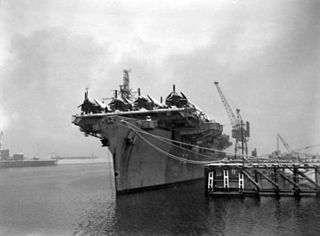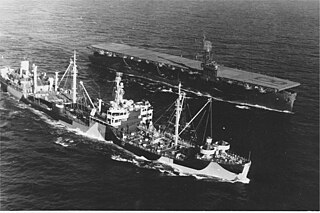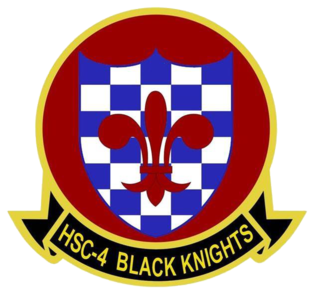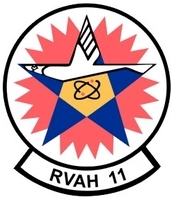The escort carrier or escort aircraft carrier, also called a "jeep carrier" or "baby flattop" in the United States Navy (USN) or "Woolworth Carrier" by the Royal Navy, was a small and slow type of aircraft carrier used by the Royal Navy, the United States Navy, the Imperial Japanese Navy and Imperial Japanese Army Air Force in World War II. They were typically half the length and a third the displacement of larger fleet carriers. While they were slower, carried fewer planes and were less well armed and armored, escort carriers were cheaper and could be built quickly, which was their principal advantage. Escort carriers could be completed in greater numbers as a stop-gap when fleet carriers were scarce. However, the lack of protection made escort carriers particularly vulnerable and several were sunk with great loss of life. The light carrier was a similar concept to escort carriers in most respects, but were capable of higher speeds to allow operation alongside fleet carriers.

USS Pybus (CVE-34) was initially a United States Navy Bogue-class escort carrier. The ship was transferred to the United Kingdom for service in the Royal Navy as the Ruler-class escort carrier HMS Emperor (D98) as part of the Lend-Lease program of World War II. Entering service in 1943, the ship took part in operations against the German battleship Tirpitz and the invasions of Normandy and southern France. Returned to the United States following the war, the carrier was sold for scrap in 1946.

HMS Ruler was a Ruler-class escort aircraft carrier of the British Royal Navy during World War II. She was built in the United States as the Bogue-class carrier St. Joseph (AVG/CVE/ACV-50) for Lend-Lease to the United Kingdom.

USS St. Lo (AVG/ACV/CVE–63) was a Casablanca-class escort carrier of the United States Navy during World War II. On 25 October 1944, St. Lo became the first major warship to sink as the result of a kamikaze attack. The attack occurred during the Battle of Leyte Gulf.

USS Kasaan Bay (CVE-69) was a Casablanca class escort carrier of the United States Navy. She was classified ACV-69 on 20 August 1942, launched as CVE-69 on 24 October 1943 by Kaiser Shipbuilding Company in Vancouver, Washington, under a Maritime Commission contract; sponsored by Mrs. R. W. Morse; and acquired and commissioned by the Navy on 4 December 1943, Captain B. E. Grow in command.

USS Rudyerd Bay (CVE-81) was a Casablanca-class escort carrier of the United States Navy. She was laid down under Maritime Commission contract on 24 October 1943 by the Kaiser Shipbuilding Company, in Vancouver, Washington; launched on 12 January 1944, sponsored by Mrs. Scott E. Peck; acquired by the Navy on 25 February 1944, and commissioned the same day, with Captain C. S. Smiley in command.

USS Petrof Bay (CVE–80) was an Casablanca-class escort carrier of the United States Navy.

USS Natoma Bay (CVE–62) was a Casablanca class escort carrier of the United States Navy.
Vereen M. Bell was an American novelist and naval officer, who was killed in action during World War II.
USS Breeman (DE-104) was a Cannon class destroyer escort in the United States Navy. The ship was named for George Breeman, a Navy seaman who was awarded the Medal of Honor for extraordinary heroism during a turret explosion on USS Kearsarge (BB-5).
USS Hubbard (DE-211/APD-53), a Buckley-class destroyer escort of the United States Navy, was named in honor of Commander Joseph C. Hubbard (1900-1942), who was killed in action, while serving aboard the heavy cruiser USS San Francisco (CA-38) during the Naval Battle of Guadalcanal on 13 November 1942.

Marine Fighter Attack Squadron 351 (VMFA-351) was a fighter squadron in the Marine Forces Reserve. The squadron was based at Naval Air Station Atlanta and participated in action during World War II and was decommissioned in 1975.

Light Photographic Squadron 62 (VFP-62) was an aviation unit of the United States Navy in service from 1949 to 1968. The squadron provided a detachment of reconnaissance planes for each of the Carrier Air Wings of the U.S. Atlantic Fleet.

USS Willis (DE–395) is an Edsall-class destroyer escort, the first United States Navy ship so named. This ship was named for Ensign Walter Michael Willis. He enlisted in the Naval Reserve as a seaman 2d class at Minneapolis. Willis received an appointment as reserve aviation cadet on 22 December 1939. Six days later, he reported to Pensacola Naval Air Station for flight instruction and, on 14 August 1940, emerged with his aviator's wings.

USS Roberts (DE-749) was a Cannon-class destroyer escort built for the United States Navy during World War II. She served in the Pacific Ocean and provided escort service against submarine and air attack for Navy vessels and convoys. Post-war, she served as a training ship until finally decommissioned in 1968.

Helicopter Sea Combat Squadron Four (HSC-4), also known as the Black Knights, is a multi-role combat helicopter squadron of the United States Navy based at Naval Air Station North Island which operates Sikorsky MH-60S Seahawk helicopters deployed aboard aircraft carriers. The squadron was originally established as HS-4 on 30 June 1952 at U.S. Naval Auxiliary Landing Field Imperial Beach with the Sikorsky HO3S-1 and was redesignated HSC-4 on March 29, 2012. It is currently assigned to Carrier Air Wing Two (CVW-2) which deploys aboard USS Carl Vinson
USS Swenning (DE-394) was an Edsall-class destroyer escort built for the U.S. Navy during World War II. She served in the Atlantic Ocean and the Pacific Ocean and provided destroyer escort protection against submarine and air attack for Navy vessels and convoys.
Fred "Buzz" Borries was an American college football player who played halfback for the Navy Midshipmen football team of the U.S. Naval Academy from 1932 to 1934.

RVAH-11 was a Reconnaissance Attack (Heavy) Squadron of the U.S. Navy. Originally established as Composite Squadron Eight (VC-8) on 3 December 1951, it was redesignated Heavy Attack Squadron Eleven (VAH-11) on 1 November 1955 and was redesignated as Reconnaissance Attack (Heavy) Squadron Eleven (RVAH-11) on 1 July 1966. The squadron was disestablished on 1 June 1975.
















